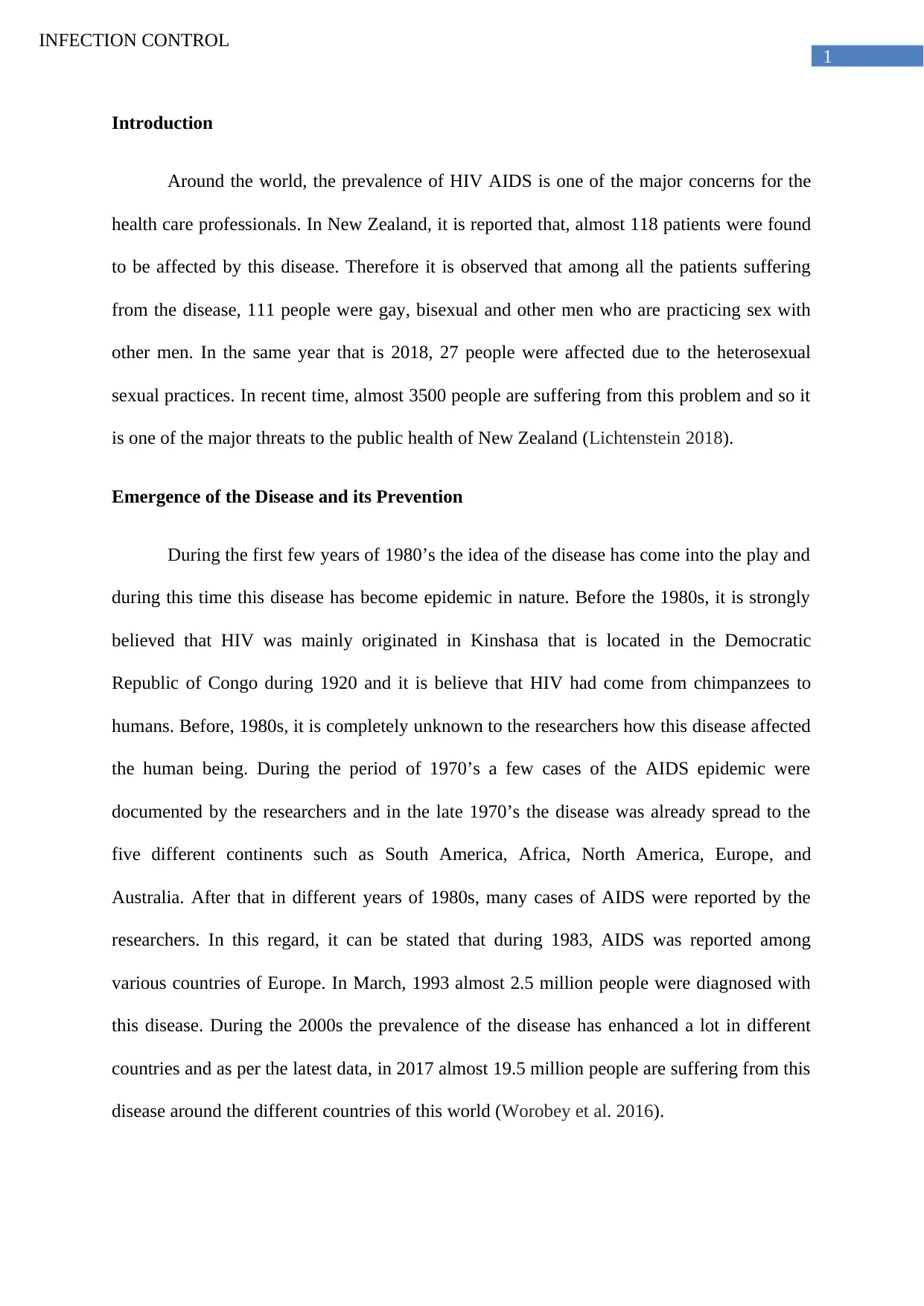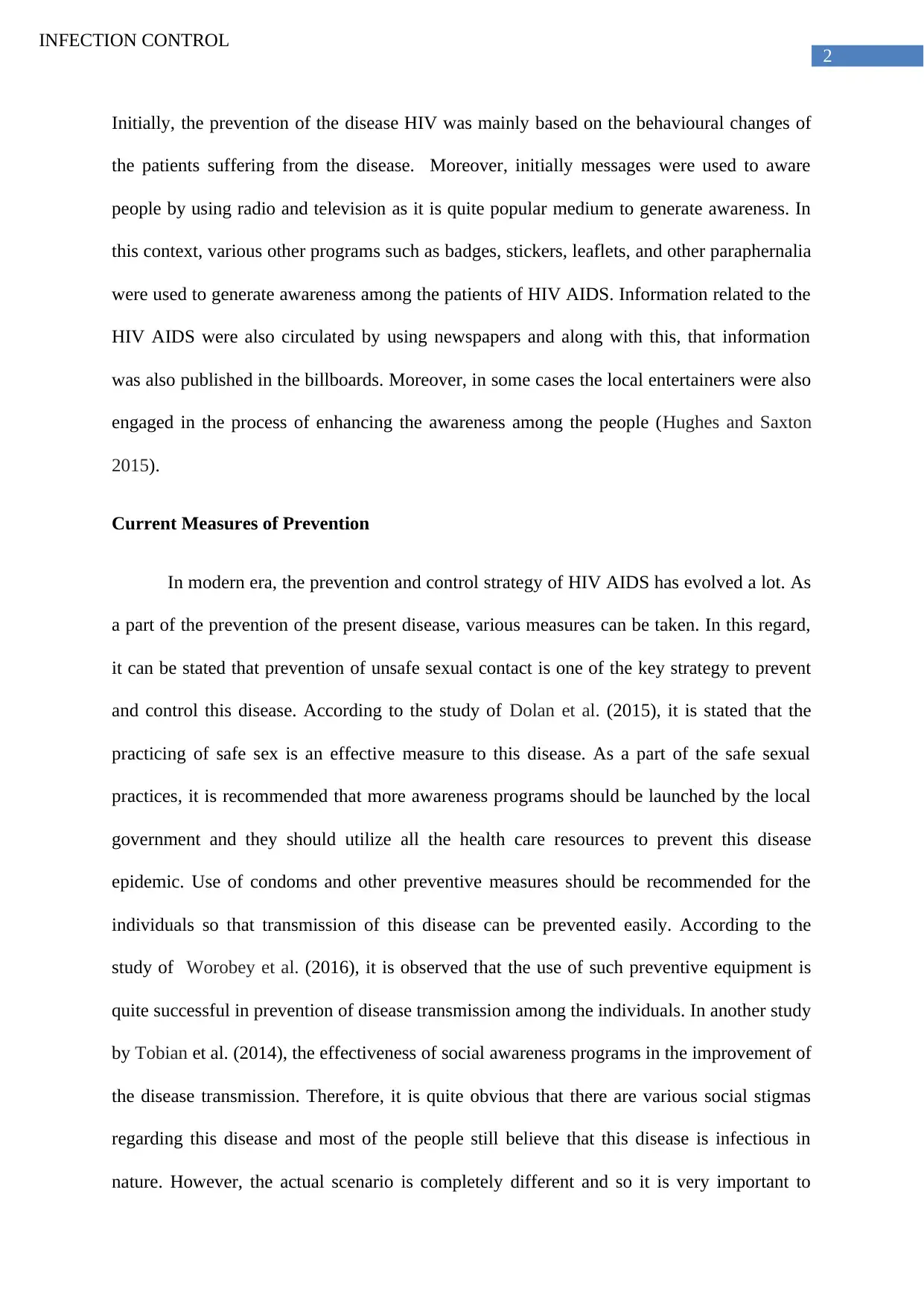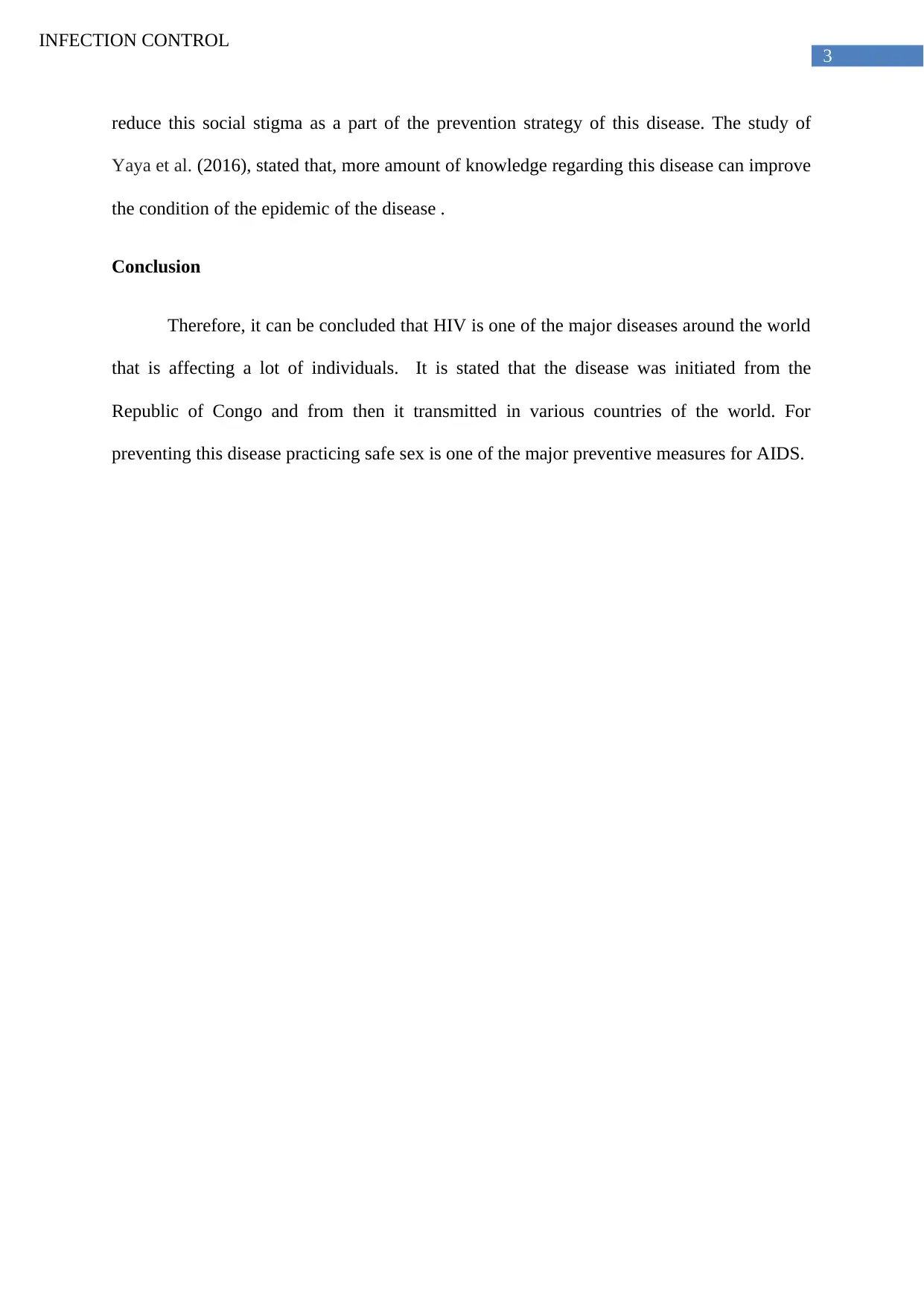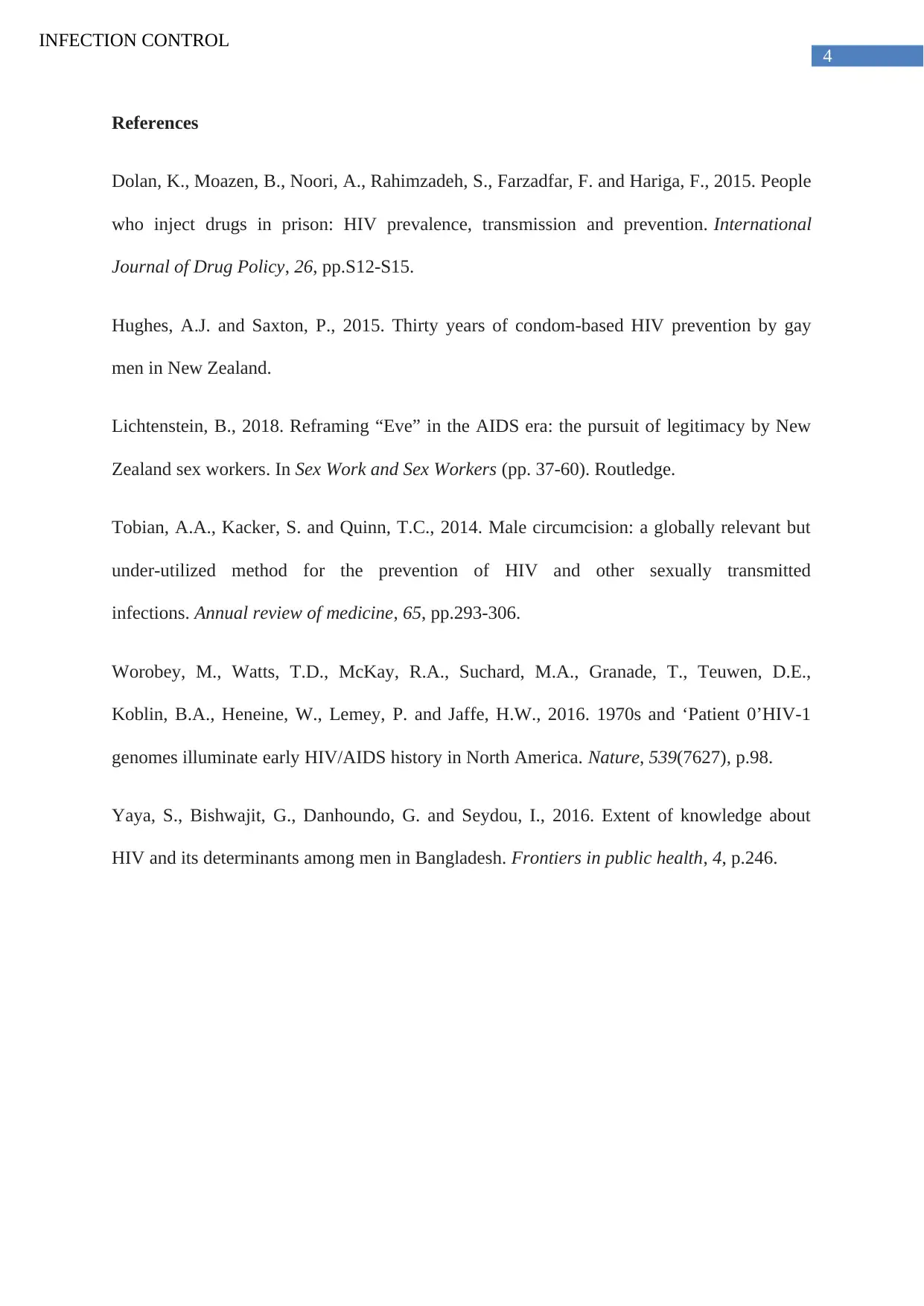Infection Control: HIV/AIDS Disease Emergence and Prevention Report
VerifiedAdded on 2022/08/23
|7
|1170
|21
Report
AI Summary
This report delves into the critical topic of HIV/AIDS infection control, focusing on its emergence and prevention strategies. It begins by highlighting the prevalence of HIV/AIDS in New Zealand, emphasizing the affected populations and the disease's significance as a public health concern. The report traces the historical emergence of the disease, from its origins in the Democratic Republic of Congo to its global spread, detailing key milestones and the evolution of understanding. It examines the initial approaches to prevention, which were primarily based on behavioral changes and awareness campaigns using various media. The report then explores modern prevention measures, emphasizing safe sexual practices, the use of condoms, and the importance of social awareness programs to combat stigma. It references several studies to support the effectiveness of these strategies. The conclusion summarizes the key points, reinforcing the importance of prevention and safe practices in managing the HIV/AIDS epidemic.

Running head: INFECTION CONTROL
Infection Control
Name of the Student
Name of the University
Author Note
Infection Control
Name of the Student
Name of the University
Author Note
Paraphrase This Document
Need a fresh take? Get an instant paraphrase of this document with our AI Paraphraser

1
INFECTION CONTROL
Introduction
Around the world, the prevalence of HIV AIDS is one of the major concerns for the
health care professionals. In New Zealand, it is reported that, almost 118 patients were found
to be affected by this disease. Therefore it is observed that among all the patients suffering
from the disease, 111 people were gay, bisexual and other men who are practicing sex with
other men. In the same year that is 2018, 27 people were affected due to the heterosexual
sexual practices. In recent time, almost 3500 people are suffering from this problem and so it
is one of the major threats to the public health of New Zealand (Lichtenstein 2018).
Emergence of the Disease and its Prevention
During the first few years of 1980’s the idea of the disease has come into the play and
during this time this disease has become epidemic in nature. Before the 1980s, it is strongly
believed that HIV was mainly originated in Kinshasa that is located in the Democratic
Republic of Congo during 1920 and it is believe that HIV had come from chimpanzees to
humans. Before, 1980s, it is completely unknown to the researchers how this disease affected
the human being. During the period of 1970’s a few cases of the AIDS epidemic were
documented by the researchers and in the late 1970’s the disease was already spread to the
five different continents such as South America, Africa, North America, Europe, and
Australia. After that in different years of 1980s, many cases of AIDS were reported by the
researchers. In this regard, it can be stated that during 1983, AIDS was reported among
various countries of Europe. In March, 1993 almost 2.5 million people were diagnosed with
this disease. During the 2000s the prevalence of the disease has enhanced a lot in different
countries and as per the latest data, in 2017 almost 19.5 million people are suffering from this
disease around the different countries of this world (Worobey et al. 2016).
INFECTION CONTROL
Introduction
Around the world, the prevalence of HIV AIDS is one of the major concerns for the
health care professionals. In New Zealand, it is reported that, almost 118 patients were found
to be affected by this disease. Therefore it is observed that among all the patients suffering
from the disease, 111 people were gay, bisexual and other men who are practicing sex with
other men. In the same year that is 2018, 27 people were affected due to the heterosexual
sexual practices. In recent time, almost 3500 people are suffering from this problem and so it
is one of the major threats to the public health of New Zealand (Lichtenstein 2018).
Emergence of the Disease and its Prevention
During the first few years of 1980’s the idea of the disease has come into the play and
during this time this disease has become epidemic in nature. Before the 1980s, it is strongly
believed that HIV was mainly originated in Kinshasa that is located in the Democratic
Republic of Congo during 1920 and it is believe that HIV had come from chimpanzees to
humans. Before, 1980s, it is completely unknown to the researchers how this disease affected
the human being. During the period of 1970’s a few cases of the AIDS epidemic were
documented by the researchers and in the late 1970’s the disease was already spread to the
five different continents such as South America, Africa, North America, Europe, and
Australia. After that in different years of 1980s, many cases of AIDS were reported by the
researchers. In this regard, it can be stated that during 1983, AIDS was reported among
various countries of Europe. In March, 1993 almost 2.5 million people were diagnosed with
this disease. During the 2000s the prevalence of the disease has enhanced a lot in different
countries and as per the latest data, in 2017 almost 19.5 million people are suffering from this
disease around the different countries of this world (Worobey et al. 2016).

2
INFECTION CONTROL
Initially, the prevention of the disease HIV was mainly based on the behavioural changes of
the patients suffering from the disease. Moreover, initially messages were used to aware
people by using radio and television as it is quite popular medium to generate awareness. In
this context, various other programs such as badges, stickers, leaflets, and other paraphernalia
were used to generate awareness among the patients of HIV AIDS. Information related to the
HIV AIDS were also circulated by using newspapers and along with this, that information
was also published in the billboards. Moreover, in some cases the local entertainers were also
engaged in the process of enhancing the awareness among the people (Hughes and Saxton
2015).
Current Measures of Prevention
In modern era, the prevention and control strategy of HIV AIDS has evolved a lot. As
a part of the prevention of the present disease, various measures can be taken. In this regard,
it can be stated that prevention of unsafe sexual contact is one of the key strategy to prevent
and control this disease. According to the study of Dolan et al. (2015), it is stated that the
practicing of safe sex is an effective measure to this disease. As a part of the safe sexual
practices, it is recommended that more awareness programs should be launched by the local
government and they should utilize all the health care resources to prevent this disease
epidemic. Use of condoms and other preventive measures should be recommended for the
individuals so that transmission of this disease can be prevented easily. According to the
study of Worobey et al. (2016), it is observed that the use of such preventive equipment is
quite successful in prevention of disease transmission among the individuals. In another study
by Tobian et al. (2014), the effectiveness of social awareness programs in the improvement of
the disease transmission. Therefore, it is quite obvious that there are various social stigmas
regarding this disease and most of the people still believe that this disease is infectious in
nature. However, the actual scenario is completely different and so it is very important to
INFECTION CONTROL
Initially, the prevention of the disease HIV was mainly based on the behavioural changes of
the patients suffering from the disease. Moreover, initially messages were used to aware
people by using radio and television as it is quite popular medium to generate awareness. In
this context, various other programs such as badges, stickers, leaflets, and other paraphernalia
were used to generate awareness among the patients of HIV AIDS. Information related to the
HIV AIDS were also circulated by using newspapers and along with this, that information
was also published in the billboards. Moreover, in some cases the local entertainers were also
engaged in the process of enhancing the awareness among the people (Hughes and Saxton
2015).
Current Measures of Prevention
In modern era, the prevention and control strategy of HIV AIDS has evolved a lot. As
a part of the prevention of the present disease, various measures can be taken. In this regard,
it can be stated that prevention of unsafe sexual contact is one of the key strategy to prevent
and control this disease. According to the study of Dolan et al. (2015), it is stated that the
practicing of safe sex is an effective measure to this disease. As a part of the safe sexual
practices, it is recommended that more awareness programs should be launched by the local
government and they should utilize all the health care resources to prevent this disease
epidemic. Use of condoms and other preventive measures should be recommended for the
individuals so that transmission of this disease can be prevented easily. According to the
study of Worobey et al. (2016), it is observed that the use of such preventive equipment is
quite successful in prevention of disease transmission among the individuals. In another study
by Tobian et al. (2014), the effectiveness of social awareness programs in the improvement of
the disease transmission. Therefore, it is quite obvious that there are various social stigmas
regarding this disease and most of the people still believe that this disease is infectious in
nature. However, the actual scenario is completely different and so it is very important to
⊘ This is a preview!⊘
Do you want full access?
Subscribe today to unlock all pages.

Trusted by 1+ million students worldwide

3
INFECTION CONTROL
reduce this social stigma as a part of the prevention strategy of this disease. The study of
Yaya et al. (2016), stated that, more amount of knowledge regarding this disease can improve
the condition of the epidemic of the disease .
Conclusion
Therefore, it can be concluded that HIV is one of the major diseases around the world
that is affecting a lot of individuals. It is stated that the disease was initiated from the
Republic of Congo and from then it transmitted in various countries of the world. For
preventing this disease practicing safe sex is one of the major preventive measures for AIDS.
INFECTION CONTROL
reduce this social stigma as a part of the prevention strategy of this disease. The study of
Yaya et al. (2016), stated that, more amount of knowledge regarding this disease can improve
the condition of the epidemic of the disease .
Conclusion
Therefore, it can be concluded that HIV is one of the major diseases around the world
that is affecting a lot of individuals. It is stated that the disease was initiated from the
Republic of Congo and from then it transmitted in various countries of the world. For
preventing this disease practicing safe sex is one of the major preventive measures for AIDS.
Paraphrase This Document
Need a fresh take? Get an instant paraphrase of this document with our AI Paraphraser

4
INFECTION CONTROL
References
Dolan, K., Moazen, B., Noori, A., Rahimzadeh, S., Farzadfar, F. and Hariga, F., 2015. People
who inject drugs in prison: HIV prevalence, transmission and prevention. International
Journal of Drug Policy, 26, pp.S12-S15.
Hughes, A.J. and Saxton, P., 2015. Thirty years of condom-based HIV prevention by gay
men in New Zealand.
Lichtenstein, B., 2018. Reframing “Eve” in the AIDS era: the pursuit of legitimacy by New
Zealand sex workers. In Sex Work and Sex Workers (pp. 37-60). Routledge.
Tobian, A.A., Kacker, S. and Quinn, T.C., 2014. Male circumcision: a globally relevant but
under-utilized method for the prevention of HIV and other sexually transmitted
infections. Annual review of medicine, 65, pp.293-306.
Worobey, M., Watts, T.D., McKay, R.A., Suchard, M.A., Granade, T., Teuwen, D.E.,
Koblin, B.A., Heneine, W., Lemey, P. and Jaffe, H.W., 2016. 1970s and ‘Patient 0’HIV-1
genomes illuminate early HIV/AIDS history in North America. Nature, 539(7627), p.98.
Yaya, S., Bishwajit, G., Danhoundo, G. and Seydou, I., 2016. Extent of knowledge about
HIV and its determinants among men in Bangladesh. Frontiers in public health, 4, p.246.
INFECTION CONTROL
References
Dolan, K., Moazen, B., Noori, A., Rahimzadeh, S., Farzadfar, F. and Hariga, F., 2015. People
who inject drugs in prison: HIV prevalence, transmission and prevention. International
Journal of Drug Policy, 26, pp.S12-S15.
Hughes, A.J. and Saxton, P., 2015. Thirty years of condom-based HIV prevention by gay
men in New Zealand.
Lichtenstein, B., 2018. Reframing “Eve” in the AIDS era: the pursuit of legitimacy by New
Zealand sex workers. In Sex Work and Sex Workers (pp. 37-60). Routledge.
Tobian, A.A., Kacker, S. and Quinn, T.C., 2014. Male circumcision: a globally relevant but
under-utilized method for the prevention of HIV and other sexually transmitted
infections. Annual review of medicine, 65, pp.293-306.
Worobey, M., Watts, T.D., McKay, R.A., Suchard, M.A., Granade, T., Teuwen, D.E.,
Koblin, B.A., Heneine, W., Lemey, P. and Jaffe, H.W., 2016. 1970s and ‘Patient 0’HIV-1
genomes illuminate early HIV/AIDS history in North America. Nature, 539(7627), p.98.
Yaya, S., Bishwajit, G., Danhoundo, G. and Seydou, I., 2016. Extent of knowledge about
HIV and its determinants among men in Bangladesh. Frontiers in public health, 4, p.246.

5
INFECTION CONTROL
INFECTION CONTROL
⊘ This is a preview!⊘
Do you want full access?
Subscribe today to unlock all pages.

Trusted by 1+ million students worldwide

6
INFECTION CONTROL
INFECTION CONTROL
1 out of 7
Related Documents
Your All-in-One AI-Powered Toolkit for Academic Success.
+13062052269
info@desklib.com
Available 24*7 on WhatsApp / Email
![[object Object]](/_next/static/media/star-bottom.7253800d.svg)
Unlock your academic potential
Copyright © 2020–2025 A2Z Services. All Rights Reserved. Developed and managed by ZUCOL.





